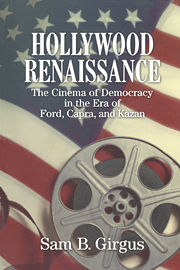Book contents
- Frontmatter
- Contents
- List of Illustrations
- Acknowledgments
- 1 Ethnics and Roughnecks: The Making of the Hollywood Renaissance
- 2 A Cinema for Democracy: John Ford and the Crisis of Modernity, Myth, and Meaning
- 3 Gender and American Character: Frank Capra
- 4 Revisioning Heroic Masculinity: From Ford to Hawks and Zinnemann
- 5 An American Conscience: Elia Kazan's Long Journey Home
- 6 Losing Tomorrow: George Stevens and the American Idea
- 7 Conclusion: Film and America after the Hollywood Renaissance
- Notes
- Filmography
- Index
5 - An American Conscience: Elia Kazan's Long Journey Home
Published online by Cambridge University Press: 05 June 2012
- Frontmatter
- Contents
- List of Illustrations
- Acknowledgments
- 1 Ethnics and Roughnecks: The Making of the Hollywood Renaissance
- 2 A Cinema for Democracy: John Ford and the Crisis of Modernity, Myth, and Meaning
- 3 Gender and American Character: Frank Capra
- 4 Revisioning Heroic Masculinity: From Ford to Hawks and Zinnemann
- 5 An American Conscience: Elia Kazan's Long Journey Home
- 6 Losing Tomorrow: George Stevens and the American Idea
- 7 Conclusion: Film and America after the Hollywood Renaissance
- Notes
- Filmography
- Index
Summary
Terry Malloy's sanctuary, his place of refuge, in On the Waterfront has been the tenement rooftop where he keeps his pigeon coop and cavorts with neighborhood youngsters who still revere him as a hero, boxer, and founder years before of their gang, the Golden Warriors. To anyone familiar with immigrant, urban, and proletarian literature and film, the symbolism of the rooftop suggests escape from the streets, the quest for freedom and transcendence, a search for solitude and privacy. With its inherent limitations of space, security, and comfort, the roof also often dramatizes confinement and failure in the search for freedom. In Henry Roth's classic immigrant novel Call It Sleep, for example, the rooftop entails all of these symbolic meanings as part of a metaphoric cosmology that incorporates the terror and evil of the basement with the hope for rebirth on the roof. So Terry (Marlon Brando) naturally will head for the roof to seek solace for himself in one of the final sequences of the film after he has testified before the State Waterfront Crime Commission against the corrupt bosses and racketeers of the longshoreman's union. By so testifying, of course, Terry has violated the great code of the mob and streets against ever informing, especially when it means turning against one's own. As a “stool pigeon,” or what the corrupt union boss Johnny Friendly (Lee J. Cobb) calls a “cheese eater,” Terry now feels totally dejected and alone, even though the murder by the mob of his brother, Charley “the Gent” (Rod Steiger) helped motivate him to testify.
- Type
- Chapter
- Information
- Hollywood RenaissanceThe Cinema of Democracy in the Era of Ford, Kapra, and Kazan, pp. 155 - 176Publisher: Cambridge University PressPrint publication year: 1998



